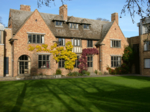Grantchester Woodland Railway

The Grantchester Woodland Railway is a 7+1⁄4 in (184 mm), 5 in (127 mm) and 3+1⁄2 in (89 mm) ridable miniature railway, in the Newnham area of Cambridge, close to Grantchester. It is affiliated to the Narrow Gauge Railway Society. Indicators of the significance of the railway include a Trainline URL giving details of how to get there using national rail services. It has been the subject of several dedicated publications, including three in 'The Model Engineer' magazine. An article published in 1955 gave details of the early history of the club, including information about the range of locomotives and carriages available. A few years later, an issue covered the subsequent creation of the public track and included photos of it being opened by Sir Vivian Fuchs. Finally, the main article in a recent issue of the magazine was dedicated to the railway. The railway is run by members of the Cambridge & District Model Engineering Society. Approximately 20 steam engines are in use, plus 2 electric engines. The track is fully signalled, with two signal boxes. There is also a level crossing and a footbridge. The area within which the tracks are located covers about 3 acres, approximately half of this being quite densely wooded. Various routes can be followed by trains, but a typical journey extends over about half a mile (taking about 10 minutes).
Excerpt from the Wikipedia article Grantchester Woodland Railway (License: CC BY-SA 3.0, Authors, Images).Grantchester Woodland Railway
Grantchester Road, Cambridge
Geographical coordinates (GPS) Address External links Nearby Places Show on map
Geographical coordinates (GPS)
| Latitude | Longitude |
|---|---|
| N 52.194729 ° | E 0.096749 ° |
Address
The Cocks and Hens Cambridge Tennis
Grantchester Road
CB3 9ED Cambridge
England, United Kingdom
Open on Google Maps








